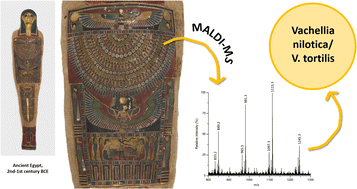New insight from MALDI-TOF MS and multivariate data analysis on the botanical origin of polysaccharide-based paint binders in ancient Egypt†
Abstract
Polysaccharide-based materials of plant origin are known to have been used as binding media in paint and ground layers of artifacts from ancient Egypt, including wall paintings, cartonnages and sarcophagi. The use of gums from Acacia, Astragalus and Prunus genera has been suggested in the literature on the basis of their qualitative or quantitative monosaccharide profile after complete chemical hydrolysis. The introduction of partial enzymatic digestion of the polysaccharide material, followed by analysis of the released oligosaccharides by matrix assisted laser desorption ionization-time-of-flight mass spectrometry, has proved effective in discriminating among gums from different genera, as well as among species within the Acacia genus. In this study, the previously built Acacia database was expanded, principal component analysis (PCA) was used to aid in grouping of the samples, and data interpretation was refined following a modified acacieae taxonomy. Application of the analytical strategy to investigate the paint binders in artworks from ancient Egypt allowed qualitative discrimination of gums at a species level, and provided new insights into the artists' material choices.



 Please wait while we load your content...
Please wait while we load your content...